Related Research Articles
The implementation of the Dayton Accords of 1995 has focused the efforts of policymakers in Bosnia and Herzegovina, as well as the international community, on regional stabilization in the countries-successors of the former Yugoslavia. Relations with its neighbors of Croatia and Serbia have been fairly stable since the signing of the Dayton Agreement in 1995.

The General Framework Agreement for Peace in Bosnia and Herzegovina, also known as the Dayton Agreement or the Dayton Accords, and colloquially known as the Dayton in ex-Yugoslav parlance, is the peace agreement reached at Wright-Patterson Air Force Base near Dayton, Ohio, United States, finalised on 21 November 1995, and formally signed in Paris, on 14 December 1995. These accords put an end to the three-and-a-half-year-long Bosnian War, which was part of the much larger Yugoslav Wars.
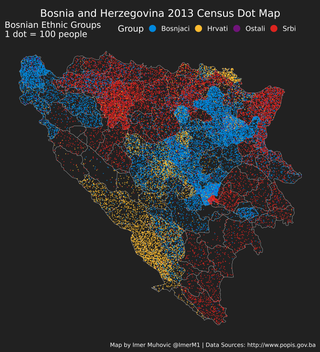
More than 96% of population of Bosnia and Herzegovina belongs to one of its three autochthonous constituent peoples : Bosniaks, Serbs and Croats. The term constituent refers to the fact that these three ethnic groups are explicitly mentioned in the constitution, and that none of them can be considered a minority or immigrant. The most easily recognisable feature that distinguishes the three ethnic groups is their religion, with Bosniaks predominantly Muslim, Serbs predominantly Eastern Orthodox, and Croats Catholic.
The Yugoslav First League was the premier football league in the Kingdom of Yugoslavia (1918–1941) and Socialist Federal Republic of Yugoslavia (1945–1992).

Igman is a mountain plateau in central Bosnia and Herzegovina. Geologically, Igman is part of the Dinaric Alps and formed largely of secondary and tertiary sedimentary rock, mostly Limestone. It is located southwest of Sarajevo, bordering the Bjelašnica range in the south and west, Hadžići and Ilidža in the north, and the river Željeznica in the east. Igman's highest point, Crni vrh, west of the Malo Polje road, at an altitude of 1,510 metres, the homonym highest elevation on the east side of this road reaches an elevation of 1,502 metres. Most of Igman is covered with mixed forest with local pastures. Igman was the location of the lowest recorded temperature in the region, −43 °C (−45 °F). Igman was the site of extensive combat during the 1992-95 Siege of Sarajevo and certain areas, in particular the surroundings of former front lines, constitute a high mine risk.

The Republic of Bosnia and Herzegovina was a state in Southeastern Europe, existing from 1992 to 1995. It is the direct legal predecessor to the modern-day state of Bosnia and Herzegovina.
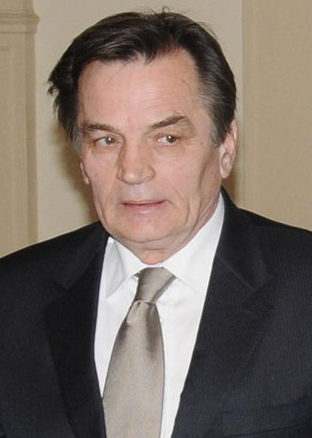
Haris Silajdžić is a Bosnian politician and academic who served as the 5th Bosniak member of the Presidency of Bosnia and Herzegovina from 2006 to 2010. He was the Prime Minister of the Republic of Bosnia and Herzegovina from 1993 to 1996.
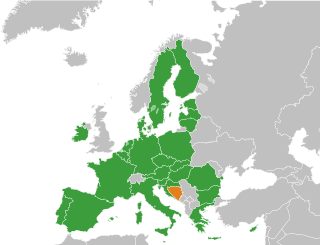
The accession of Bosnia and Herzegovina to the European Union (EU) is the stated aim of the present relations between the two entities. Bosnia and Herzegovina has been recognised by the European Union as a "candidate country" for accession since the decision of the European Council in 2022 and is on the current agenda for future enlargement of the EU. Bosnia and Herzegovina takes part in the Stabilisation and Association Process and trade relations are regulated by an Interim Agreement.

The Novi Sad Agreement was a document composed by 25 Serbian, Croatian and Bosnian writers, linguists and intellectuals to build unity across the ethnic and linguistic divisions within Yugoslavia, and to create the Serbo-Croatian language standard to be used throughout the country.
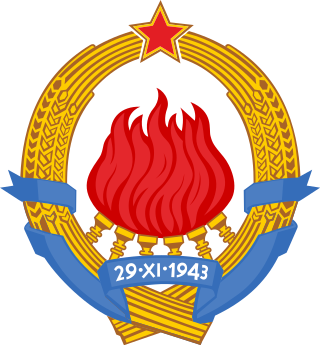
Yugoslavia had various administrative divisions throughout its 74 years of existence.
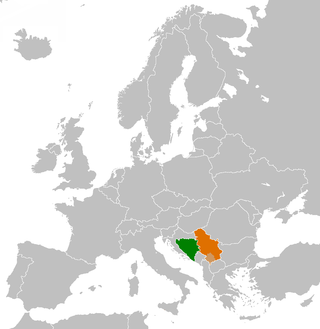
The modern-day countries of Bosnia and Herzegovina and Serbia both originated from Yugoslavia. The majority of population in both countries speak one of the standard varieties of Serbo-Croatian and Serbia is one of the largest investors in Bosnia and Herzegovina.

The foreign relations between Bosnia and Herzegovina (BiH) and Croatia are bound together by shared history, language, neighboring geography and cultural commonalties. They established diplomatic relations in 1992, following the dissolution of Yugoslavia and independence of Croatia. The two countries share a 932-kilometer (579 mi) border – the second longest external land border in the European Union (EU). Modern relations between the two states are functional but remain tense after ineffective 21st-century attempts at détente.

Živorad Kovačević was a Yugoslav and Serbian diplomat, politician, NGO activist, academic and writer.
The Youth Initiative for Human Rights or YIHR is a network of autonomous non-governmental organizations active in Serbia, Kosovo, Croatia, Montenegro and Bosnia and Herzegovina. It is focused on building connections and establishing cooperation between young people from different ethnic groups in Balkans.

Bosnia and Herzegovina and the Holy See have maintained diplomatic relations since the former declared independence in 1992. The two states have signed a concordat, and there have been three papal visits to the multiconfessional Bosnia and Herzegovina. The relations with the Holy See have generally been fostered primarily by the Bosnian Croat and Bosniak officials, but sometimes aggravated by Bosnian Serb officials.
The Islamic Community of Bosnia and Herzegovina is a religious organisation of Muslims in Bosnia and Herzegovina. It is also recognised as the highest representative body of Muslims in the region, especially in Serbia (Sandžak), Croatia, Slovenia, Montenegro, Hungary and Bosniak diaspora.
The Sutorina dispute was a border dispute between Montenegro and Bosnia and Herzegovina regarding the sovereignty over the territory of Sutorina. Since the Berlin Congress of 1878 the territory of Sutorina had been a part of Bosnia and Herzegovina within Austria-Hungary and later the Kingdom of Yugoslavia, but in the aftermath of World War II in 1947 it became part of SR Montenegro within FPR/SFR Yugoslavia. After the breakup of Yugoslavia, control of the territory was retained by Montenegro, but some Bosnian officials claimed that the territory transfer had been illegal, disputing Montenegrin sovereignty over the area. In 2015, the two countries reached an agreement which gave the sovereignty over the territory to Montenegro.

UDIK, the Association for Social Research and Communications, is the Bosnian non-governmental organization with offices in Sarajevo and Brčko. It was founded in 2013 by Edvin Kanka Ćudić. Organization aimed to gather facts, documents, and data on genocide, war crimes, and human rights violations in Bosnia and Herzegovina and the former Yugoslavia.

Israel–Yugoslavia relations were historical foreign relations between Israel and now split-up Socialist Federal Republic of Yugoslavia. Positive initial relations between the two states were subsequently negatively affected by the Arab–American conflict and close relations between Yugoslavia and some Arab states, particularly Yugoslav relations with Egypt. Despite cancelation of the formal relations after the Six-Day War informal, commercial and cultural exchanges continued throughout the Cold War period.

The Church of Jesus Christ of Latter-day Saints in Croatia refers to the Church of Jesus Christ of Latter-day Saints and its members in Croatia. The first missionaries arrived in Croatia in 1974. In 2022, there were 633 members in 6 congregations.
References
- ↑ "Igman Initiative: Mission" . Retrieved April 29, 2014.
- ↑ In an interview with Radio Free Europe one of the activist, Ivan Stambolić, said “because of the people in Sarajevo and solidarity with them, but also in support of the people in Serbia who have been against the war and destruction of the city and the people in it, but also because of war monger and instigators . . . with this act I want to show that patriotism, lest humanism, is a lie.”
- ↑ At that time the Federal Republic of Yugoslavia (FRY) still consisted of Serbia and Montenegro.
- 1 2 3 "Igman Initiative: History" . Retrieved April 29, 2014.